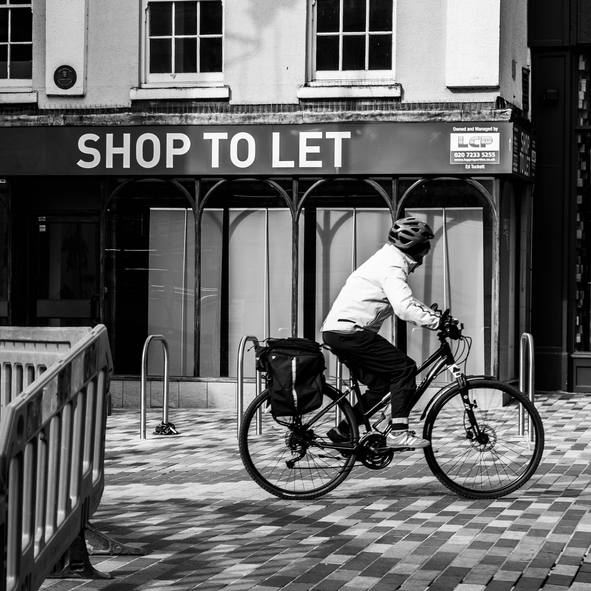
We’re a country that turns a blind eye to the danger caused by pavement parking, but the same can’t be said of our attitudes towards cycling on the footway. And yet, Minister for Cycling Robert Goodwill has this week restated the official line from the Department for Transport (DfT) that cyclists may ride on pavements – on condition they do so considerately. He called on police officers need to exercise discretion following an announcement by the Metropolitan Police that almost 1,000 cyclists had been fined for pavement cycling as part of its Operation Safeway.
In an email to Donnachadh McCarthy of the pressure group Stop Killing Cyclists, which recently held protests outside the headquarters of Transport for London (TfL) on Southwark Bridge Road and at Vauxhall Cross, the minister said that original guidance issued by the Home Office 15 years ago when Fixed Penalty Notices (FPNs) were introduced is still valid:
“The introduction of the fixed penalty is not aimed at responsible cyclists who sometimes feel obliged to use the pavement out of fear of traffic and who show consideration to other pavement users when doing so. Chief police officers, who are responsible for enforcement, acknowledge that many cyclists, particularly children and young people, are afraid to cycle on the road, sensitivity and careful use of police discretion is required.”

The issue was raised by campaign group Stop Killing Cyclists to highlight the dangers faced by cyclists in London – in particular at dangerous junctions such as Vauxhall Cross.
Mr Goodwill told Donnachadh McCarthy of the pressure group: “Thank you for bringing the issue of cycling on the pavement around dangerous junctions such as Vauxhall Cross to my attention. I agree that the police should be using discretion in enforcing this law and would support Paul Boateng’s original guidance. You may wish to write to Sir Hugh Orde, President of the Association of Chief police Officers, to bring this matter to his attention too.”
The National Police Chiefs’ Council response to the re-issuing of the guidance can be read here.
The ethical choice
The ETA was established in 1990 as an ethical provider of green, reliable travel services. Over 30 years on, we continue to offer cycle insurance , breakdown cover and mobility scooter insurance while putting concern for the environment at the heart of all we do.
The Good Shopping Guide judges us to be the UK’s most ethical provider.

John Harpur
Cycling on the pavement has been illegal for nearly 150 years. It is dangerous for pedestrians and especially disabled persons. Whilst acknowledging the dangers created by modern congested roads, it should be no excuse to now add extra dangers on pavements, especially with escooters adding extra hazards. Pavement cycling is illegal and should stay so. Show some common sense!
David Curran
This is all very well, but generates a great big argument between an offending “cyclist” and the police about just what constitutes “showing consideration to other pavement users”.
If an adult can’t use the road for fear of danger from traffic, or because they don’t have sufficient skill to feel safe, these are separate issues – they need to obtain cycle coaching, or demand safety improvements be made to the offending roads. You mention dangerous road junctions, but these often have to be crossed by cyclists whether they are on the carriageway or the footpath, in fact more junctions have to be crossed when using footpaths.
Every time someone decides to ride their bike on a pedestrian pathway, they unacceptably increase tension, worry and safety for pedestrians.
John
Cycling on the pavement has been illegal for over 150 years. It is a danger to ordinary pedestrians, visually impaired, disabled using mobility devices and persons pushing buggies with children.
It should not be allowed.
Daniel
Until there is proper and decent quality cycle infrastructure in place, allowing considerate cycling on the pavement makes sense as a useful interim measure until proper, purpose built, dutch-style cycle infrastructure is in place, because anyone who cycles has to choose between obeying the law yet putting themselves in greater danger by having to share a busy main road or breaking the law but keeping themselves safe from motor traffic danger. This is not right. The 1835 Highways Act, which predates the invention of the internal combustion engine, is therefore not fit for purpose and needs to be repealed. As a stopgap, until there is dutch style cycle infrastructure, legalise cycling on the pavement, but on condition that this is done considerately and responsibly, and that cyclists use bells to warn others of their presence and use good lights at night, cycle at speeds appropriate to tue conditions etc and that no reckless or irresponsible cycling is to be allowed. This would be a more common sense approach and would help to address some of the barriers to cycling in the first place.
Simon Buddingwood
As a considerate cyclist I regularly cycle on pavements when I can see there are no pedestrians around and the road is unsafe. However I always dismount and push my bike if there are people around or if I can’t see round an obstacle to see if a pedestrian might be coming, this is what I see most cyclists do or at the very least slow down to travel very slowly not much above a brisk walking pace. Although I recognise there are an inconsiderate and dangerous minority who don’t do this. However the same can’t be said of pedestrians use of marked cycle lanes. Regularly I have to dodge or stop to avoid pedestrians walking in or across marked cycle lanes that are off the road that are supposed to be exclusively for bikes (I’m not talking canal tow paths here) and mostly the response to me using my bell is one of derision and entitlement, it seems many pedestrians feel that segregated cycle lanes which are not on the road are an extension of the pavement. If a pedestrian in a cycle lane causes an accident involving injury or damage to the cyclist or their posessions should they be prosecuted for dangerous or furious walking?
michael ROYSTON shankland
I alm 75 and have severe copd I have cycled all my life but now on some parts of the road I feel unsafe cycling ad therefore at times I do cycle on the pavement I can no longer cycle very fast and when on the pavement I am always very careful and very considerate towards pedestrians. I get severely out of breath walking even very short distances but I can cycle a number of miles without getting seriously out of breath. My bycicle is like a wheelchair to me and takes much less space on the pavement than a wheelchair does.I do use cycle routes where they are available but many of the cycle lanes at the side of the road are useless as vehicles are allowed to park on them and buses frequently stop in them forcing cyclists either into the middle of the road or on to the pavement .
Anne Balasingam
I am a lady, getting on in years, thinking of buying a bicycle to keep me fit. I am very nervous about riding on the roads around where I live and this is preventing me from buying a bicycle. I am also a very responsible and considerate person and would ride responsibly on the pavement.
Anne Balasingam
THERE SHOULD BE MORE CYCLE PATHS IN ALL AREAS OF THE UK NEXT TO BUSY ROADS.
IN THE AREAS WITH BUSY ROADS AND NO CYCLE PATHS, PEOPLE SHOULD BE ALLOWED TO RIDE ON THE PAVEMENT AS LONG AS THEY DO IT RESPONSIBLY. WE NEED MORE CYCLE PATHS IN DURHAM CITY.
Jake Smith
John says “it is a danger to ordinary pedestrians, visually impaired, disabled using mobility devices and persons pushing buggies with children”. Maybe, if there are any pedestrians. But what if it is empty. So, sorry, I will continue to use empty pavements (with care) on dangerous roads.
Claire
I have a physical disability and can only move slowly. As a result I have been knocked down by reckless cyclists, riding on the pavement, three times in five years. I live in a suburb of a provincial town – the roads are often totally empty at the time. Their entitlement leaves me beside myself. Only last month a cyclist barrelling down the pavement towards me shouted out to “Sorry, I can’t go on the road ‘cause I have no lights and I’ve been drinking!” as I stumbled into the hedge. There really are no words, are there? I have nightmares now, and wake up sweating and crying out, diving out of my bed, having dreamed that a cyclist was just about to run into me again. When I’m out and I reach a corner I hold myself flat against the wall and peek around to check whether I will be run over. I can’t drive because of my impairment. If I didn’t walk I would be housebound. I feel so helpless because they don’t have number plates. I can’t call the police to report them. There is no such thing as riding on the pavement ‘considerately’.
Déborah Libby
If the law is in place that bans cyclists from riding on the pavement why was Celia Ward ( Huntington )not found guilty of the offense and therefore had contributed to her own death. At the time of the incident why did she not stop to let a person walking with an obvious disability pass in safety, especially when there was a lamppost in the pavement . Did Auriol Grey have a adequate defence.